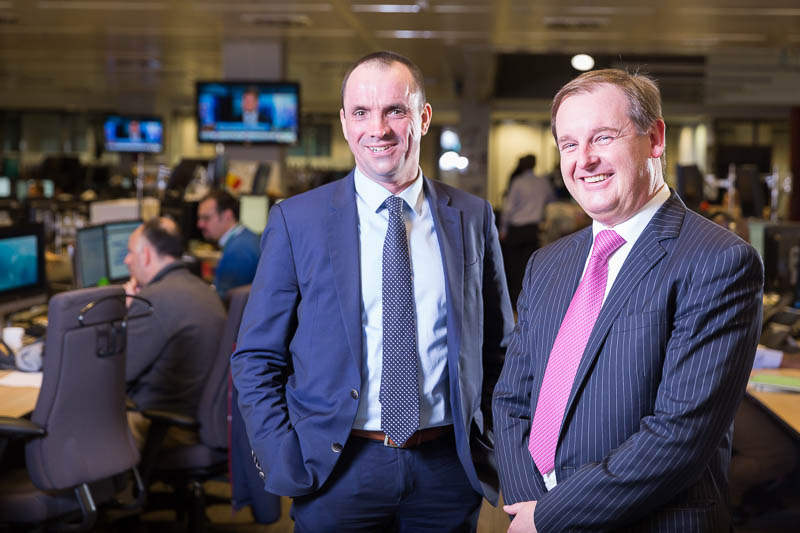At the beginning of 2022, for a while it looked like we were nearing the peak of inflation. However, the war in Ukraine and new lockdowns in many Chinese cities quickly dashed these hopes.
Koen De Leus: “Global supply chains are once again seriously disrupted. Cost pressures are increasing further, and the resulting inflation is peaking later than expected. It is also more persistent and will take a higher toll than we estimated a year ago.”
As long as the supply side continues to fuel inflation, the pressure for central banks to intervene also persists. This is especially true in the United States, where wages are also rising sharply. The big question for the economy is how far central banks will go to tackle inflation. There is nothing they can do on the supply side, but they can do something on the demand side. If interest rates rise too much, however, there is a risk that growth will be undermined altogether.
Today we are assuming short-term interest rates of 3 to 3.25 per cent in the United States by mid-2023. In Europe, we see interest rates peaking at 2 per cent by then. We do not rule out a hard landing.
China: Covid and the property sector
The zero-Covid policy is pushing the Chinese economy into recession this quarter. Due to the low vaccination rate among the elderly, trying another approach is not an option for the time being. In the run-up to the important Communist Party Congress in October, the Chinese regime wants to avoid losing face at all costs.
In addition, the high mountain of debt in the real estate sector is keeping the Chinese economy in a stranglehold. China has 2700 billion US dollars in foreign debt, which more or less equals its own reserves in that currency. How much of that debt is linked to the Chinese property sector is unclear.
The renminbi’s weakening against the dollar is making it increasingly difficult for Chinese companies to meet their dollar obligations. But raising interest rates in the current environment would only further undermine the property sector. The banking sector risks becoming the next victim.
Koen De Leus: “The outflow of dollar liquidity and the falling trend of the renminbi are likely to continue in the coming months. As a result, real estate companies will find it increasingly difficult to refinance their debts in the coming years, let alone repay them. History has taught us that a credit-driven property boom often ends painfully. The question is whether China will be able to escape this.”
A new debt drama in the making?
Some three out of five loans that China has granted to developing countries are in trouble. That corresponds to the total share of low-income countries that have payment problems. Ten years ago, it was barely one in three. In the past, rising US interest rates were often accompanied by debt crises in those countries. That’s because in those poorer economies interest rates then also went up. The tightening of financial conditions, topped off by a strengthening US dollar against their own currency, was often too much to bear. A wave of debt and banking crises followed.
Today, a new debt drama seems to be in the making. Both public and private debt in developing countries rose steadily in the 2010s, and explosively during the COVID-19 pandemic. The recovery after the pandemic was underwhelming and growth prospects are bleak. High inflation undermines purchasing power. The share of food in the total consumption basket in these low- and middle-income countries fluctuates from 20 to as much as 50 per cent, as in India, for example.
Fortunately, most of these countries have learned from the past and have halved the share of foreign debt to 12 per cent. But interest from foreign investors has also waned, leaving many government loans in local banks. If public debt comes under pressure, banks are also in danger of running into trouble, which means local lending is likely to dry up. International debt restructuring may be able to prevent a new crisis. But the large share of loans that China holds in those countries makes an agreement difficult.
Belgium and the other European countries
As long as the average interest burden paid by governments remains below nominal growth, there is no chance of a debt snowball in the developed countries. A debt crisis is therefore not in sight for most countries. But gradual fiscal consolidation is imminent.
To stabilise its debts at the current level, Belgium must reduce its budget deficit from 5.5 per cent in 2021 to 1.2 per cent. Most other European Member States also need to improve their budget deficits in the long run. This varies from country to country, and is highest in Italy at 6.3 per cent. The Scandinavian countries are, as so often, the top students in the class. In Italy, meanwhile, the interest rate differential with Germany is rising rapidly.
Rising interest rates are not without consequence for real estate either, especially after the rapid price increases during the Covid pandemic. Belgian mortgage rates are almost 2 per cent higher than at the beginning of 2022. The increasing repayment burden threatens to put affordability under pressure, especially among young people. Rising incomes partly compensate for this, but rising construction costs cancel these out. However, the uncertainty surrounding the cost of raw materials is also causing supply to cool today. We expect a further slight increase in property prices, but this will not be as high as inflation.
For the current quarter, we expect barely any growth, hopefully followed by positive growth in the coming quarters. On an annual basis, this results in an apparently solid growth of 2.1 per cent, but we need to take into account a large base effect of 1.9 per cent. Effective growth in 2022 will therefore actually be barely 0.2 per cent. The coming weeks and months will be crucial. The uncertainty surrounding Russian gas supplies, the war in Ukraine and Chinese lockdowns are keeping inflation high. This is undermining purchasing power - and thus consumption. The stagflation risk threatens to derail into a global recession.
Monetary policy of central banks
In a world of negative real interest rates, real assets are needed and cash is of no interest in the longer term. Until a few months ago, it was expected that central banks would at some point have to normalise their monetary policy and thus reduce the liquidity in the system. This would lead to volatility in the markets.
The war in Ukraine accelerated a number of things. Inflation increased and central banks, especially the Federal Reserve, had to apply the monetary brake more quickly. We had the sharpest rise in interest rates in 200 years of market history, which caused a correction in the equity markets. Technology stocks in particular, which are very sensitive to interest rates because they have much of their profits in the future, were hit hard.
Equity
Today, BNP Paribas Fortis' strategy for the equity markets remains unchanged.
Philippe Gijsels: “In the slightly longer term, we remain committed to real assets. In the shorter term, we continue to expect more volatility because the transition period, during which the markets have to get used to the fact that the money supply is slightly less open, has not yet ended. The technical picture, the trend, currently remains very negative. So investors are still waiting for that trend to change.”
At some point, however, a new bull market will start. The sectors, themes and groups that lead the way when the market bottoms out are usually the leaders of that new bull market. It is still too early to say, but big contenders are alternative energy, biotech, the metaverse, robotics and internet security.
Bonds
Real interest rates are rising slightly. For example, in US bonds (government and corporate), there is some interest to be gained. We expect the US dollar to remain firm. The acronyms TINA (There Is No Alternative) and TRINA (There Really Is No Alternative) seem to have been replaced by TINAC (There Is No Alternative Country). The latter then refers to the United States.
Commodities
A possible slowdown in the global economy and especially (economic) concerns in China could put some pressure on commodity markets (especially metals) in the coming months.
In addition, the conflict in Ukraine creates a very binary situation. In case of a negotiated solution, commodity prices could fall sharply, whereas they could rise even more if there is a further escalation. This makes these markets extremely volatile and at the moment, difficult to invest in. Over a slightly longer time horizon, we remain in a structural and long-term bull market, of which we have only seen a very small part, mainly driven by a supply shortage.
Philippe Gijsels: “When we add it all up, it is clear that we have entered a new investment world, where it will be important to be on the ball and where active management will be able to show its value more than ever.”
BNP Paribas Fortis (www.bnpparibasfortis.com) offers the Belgian market a comprehensive range of financial services for private individuals, the self-employed, professionals, companies and public organisations. In the insurance sector, BNP Paribas Fortis works closely, as a tied agent, with Belgian market leader AG Insurance. At international level, the Bank also provides high-net-worth individuals, large corporations and public and financial institutions with customised solutions, for which it is able to draw on the know-how and international network of the BNP Paribas Group.
BNP Paribas (www.bnpparibas.com) is the European Union’s leading bank and key player in international banking. It operates in 68 countries and has more than 193,000 employees, including nearly 148,000 in Europe. The Group has key positions in its three main fields of activity: Retail Banking for the Group’s retail-banking networks and several specialised businesses including BNP Paribas Personal Finance and Arval ; Investment & Protection Services for savings, investment and protection solutions ; and Corporate & Institutional Banking, focused on corporate and institutional clients. Based on its strong diversified and integrated model, the Group helps all its clients (individuals, community associations, entrepreneurs, SMEs, corporates and institutional clients) to realise their projects through solutions spanning financing, investment, savings and protection insurance. In Europe, BNP Paribas has four domestic markets: Belgium, France, Italy and Luxembourg. The Group is rolling out its integrated retail-banking model across several Mediterranean countries, Turkey, Eastern Europe as well as via a large network in the western part of the United States. As a key player in international banking, the Group has leading platforms and business lines in Europe, a strong presence in the Americas as well as a solid and fast-growing business in Asia-Pacific. BNP Paribas has implemented a Corporate Social Responsibility approach in all its activities, enabling it to contribute to the construction of a sustainable future, while ensuring the Group's performance and stability.

